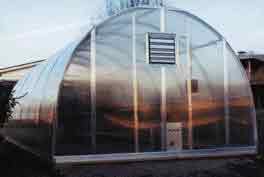
![]() Through October 15, 2008, the public is welcome to view an open-access webcast on seedborne pathogens of soybean developed and recorded by Dr. Gary Munkvold, a research plant pathologist at Iowa State University.
Through October 15, 2008, the public is welcome to view an open-access webcast on seedborne pathogens of soybean developed and recorded by Dr. Gary Munkvold, a research plant pathologist at Iowa State University.
Like most crops, soybeans are vulnerable to diseases caused by seedborne pathogens. These diseases can cause significant yield loss, reduce seed quality, and/or create obstacles to seed export due to phytosanitary concerns. Many microorganisms can be seedborne, but relatively few have a consistent economic impact on soybean production. In this recorded presentation, Dr. Munkvold discusses how microorganisms can have different types of associations with seeds and which ones are important in soybeans. The presentation also briefly covers the methods used to detect certain seedborne pathogens in soybean and a few management tips. View here: http://www.plantmanagementnetwork.org/edcenter/seminars/SampleWebcast/
Plant Management Network (PMN) is a not-for-profit, online publishing effort whose mission is to enhance the health, management, and production of agricultural and horticultural crops. PMN achieves this mission by developing science-based resources that help researchers, crop management professionals, consultants, growers, educators, and students make better plant management decisions and recommendations.
PMN is jointly managed by the American Phytopathological Society, American Society of Agronomy, and Crop Science Society of America, in conjunction with many other partners, including scientific societies, agricultural universities, and agribusiness.

![]() Larger than usual soybean aphid populations have been
reported by a crop consultant in Adair, Boyle and Lincoln
counties in central Kentucky. In addition, aphid numbers
in our sentential plot in Shelby Co. have increased
significantly. Throughout the season we have seen small
numbers of soybean aphid over most of the Kentucky
soybean production area but they have been below levels
that cause concern. As I mentioned in the last two articles,
we are likely to see increasing soybean populations in
late-maturing beans. This is largely due (in my opinion)
to cooler temperatures during late summer - early fall
which allow increased aphid reproduction. These larger
populations are most likely to occur in the production
area that lies between I-65 and I-75. This is borne out by
historic observations.
Larger than usual soybean aphid populations have been
reported by a crop consultant in Adair, Boyle and Lincoln
counties in central Kentucky. In addition, aphid numbers
in our sentential plot in Shelby Co. have increased
significantly. Throughout the season we have seen small
numbers of soybean aphid over most of the Kentucky
soybean production area but they have been below levels
that cause concern. As I mentioned in the last two articles,
we are likely to see increasing soybean populations in
late-maturing beans. This is largely due (in my opinion)
to cooler temperatures during late summer - early fall
which allow increased aphid reproduction. These larger
populations are most likely to occur in the production
area that lies between I-65 and I-75. This is borne out by
historic observations.
It is unlikely, but not impossible, that these populations will eventually require insecticidal treatment. The threshold for Soybean Aphid remains:
Beans in R6 or later would need many more aphids per plant to warrant control and payback is unlikely. In addition to these plot and field counts, the aphid suction traps in Lexington, KY and in Dixon Springs, IL have caught only a few soybean aphids. Suction traps in Princeton, KY and Portageville, MO have not yet captured any. Suction trap captures for the remainder of the year are unlikely to have relevance to the 2008 infestation. These aphids have already begun the reverse migration back to their overwintering host. They are therefore moving out of beans.
Producers and consultants should remain on the lookout in late maturing beans.
For more information about soybean pests, visit
"Insect Management Recommendations".



Well the hot weather is over with and many of the summer insect problems are reduced, but whiteflies are still a problem in and around greenhouses. One of the more notable and unusual problems has been the large numbers of whiteflies, particularly the silverleaf whitefly, Bemisia argentifolii. We have seen very high numbers this year as hot, dry weather (which there has been no lack of this summer) favors the buildup of this insect.
We have seen some unusual problems associated with this whitefly this year, including the transmission of Tomato Yellow Leaf Curl in some greenhouse tomatoes. This is a devastating disease that completely shuts down fruit production and plant growth. Unfortunately, only very low numbers of the silverleaf whitefly are needed to transmit the virus throughout an entire greenhouse. Often these problems in the greenhouse are initiated outside the greenhouse in unmanaged weedy areas. Here are some recommendations to reduce the likelihood of whitefly problems:
Last year, Dr. Tim Coolong and I reported on the silverleaf of cucurbits, but the irregular ripening of tomatoes is a new report. There are a number of causes of irregular ripening of tomatoes that includes yellow shouldering, gray wall and blotchy ripening. The causes of these are often attributed to nutrients (potassium/nitrogen) balances and environmental conditions (soil compaction, cool-wet weather, or very hot weather). However, the irregular ripening caused by silverleaf whitefly appears a bit different than the other types of ripening disorders. What we observed is that if one looked at the fruit from above, a section of the fruit did not ripen and remained green to the core, while the rest ripened normally. In some instances, one half of the fruit would be ripe while the other side was green. Only moderate infestation of silverleaf whitefly was noted on these plants. Research in Florida noted that densities of 5 to 10 nymphs per leaflet may be used as a threshold for management of silverleaf whitefly and irregular ripening on tomato. Besides the noted problems on cucurbits and tomatoes, high silverleaf whitefly numbers have been observed on a large number of other plants. On most of these the damage is not important. Whitestalk in broccoli, another disorder that can appear with this pest, has not been reported in Kentucky. As homeowners prepare to bring in houseplants prior to the first killing frosts this fall, care should be taken to avoid bringing whitefly infested plants indoors.


The fall generation of the hemlock woolly adelgid will be underway soon. The dark-bodied crawlers with distinctive fringed white edges can be seen on twigs and branches of infested trees. In a few weeks, the wooly white egg sacks will be visible in infested trees. Forest infestations have been detected in Bell, Clay, Harlan, Letcher, Leslie, Pike, and Whitley counties. More specific locations can be found at http://www.uky.edu/~sfei2/hwa.htm.
Suspected infestations, along with distribution information on eastern hemlocks is vital to managing
this invasive insect. Information on the adelgid in Kentucky is available in Entfact 452 at
http://www.uky.edu/Ag/Entomology/entfacts/trees/ef452.htm. A survey form for reporting is available on line at www.kyforesthealth.org/HWAsurvey.doc.

 This wasp belongs to the family Ichneumonidae with over 3,000 species in North America. They are important natural enemies of many plant feeding insects.
This wasp belongs to the family Ichneumonidae with over 3,000 species in North America. They are important natural enemies of many plant feeding insects.
Members of the genus Megarhyssa look like yellowjacket wasps and appear to have an intimidating stinger but it's just a specialized egg-laying tool. These wasps lay their eggs in logs or dead branches infested with the larvae of wood boring insects. The long tails of the wasp join to form a drill that the wasp carefully guides into wood to leave her egg near a borer larva. The grub that hatches from the wasp egg will feed on the borer larva, producing another ichneumon wasp. Ichneumon wasps mimic stinging wasps and will attempt to "sting" if handled but do not have venom.

NOTE: Trade names are used to simplify the information presented in this newsletter. No endorsement by the Cooperative Extension Service is intended, nor is criticism implied of similar products that are not named.
Lee Townsend
Extension Entomologist